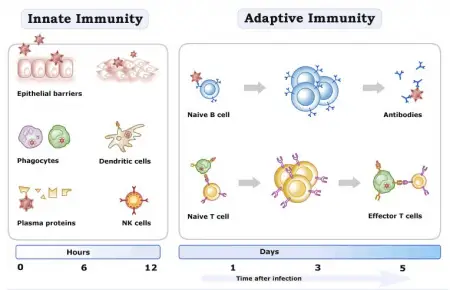The immune system is well-equipped with barriers and cells to protect our body from infection invasion. The two categories of immunity are innate (non-specific) and adaptive (acquired). This article will tackle the difference between the two.
Summary Table
| Innate Immunity | Adaptive Immunity |
| Skin, mucous membranes, white blood cells, plasma proteins, natural killer cells, dendritic cells | T cells and B cells |
| General protection | Specific to antigens |
| Always present even in the absence of antigen | Silent in the absence of antigen |
| Immediate action | 1-2 weeks before action |
Definitions

Innate (or “non-specific”) immunity refers to immunity present in the body designed for protection even in the absence of an antigen. Its purpose is heightened in the presence of an antigen. Examples of innate immunity in the body includes: the skin, which is considered the first line of defense; mucosal linings, which trap dirt (that might enter the lung, for example); white blood cells, which immediately respond in the presence of foreign bodies; and other cells in the immune system that are readily present to attack antigens and/or their derivatives.
Innate immunity serves as the first aid in the presence of antigens. If it is not effective, adaptive immunity takes over.
Adaptive (or “acquired”) immunity refers to immunity that is activated by a specific antigen. Before adaptive immunity becomes activated, the antigen has to be processed and analyzed. Once the immune system realizes that the antigen is a foreign body, immune cells will be activated to kill the antigen. This type of immunity is also capable of remembering and recognizing previous infections so if the same antigens attack again, the immune cells will be ready to clear the infection. Examples include T cells that serve as the actual “fighters” of the infection and the B cells which function as the “protectors” by creating antibodies for that specific antigen.
Innate vs Adaptive Immunity
So what is the difference between innate and adaptive immunity? The main difference lies in the target of their components. Innate immunity works as a general protector against any foreign invaders while adaptive immunity works on specific pathogens that cannot easily be warded off.
Innate immunity is composed of the skin, mucous membranes, white blood cells, plasma proteins, natural killer cells, and dendritic cells. On the other hand, adaptive immunity consists of T cells and B cells.
In the presence of injury or foreign bodies, innate immunity works first since it is always present and readily available. If the pathogen is not cleared by the innate immunity, adaptive immunity, which is more potent and more specific, comes into play. The downside is that adaptive immunity takes around 1-2 weeks before it kicks in.
Video
To understand the topic clearly, watch this video that illustrates how innate and adaptive immunity works.






